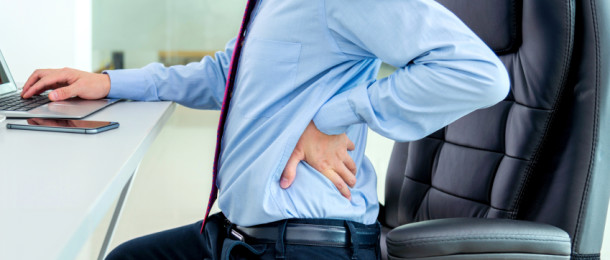9 Ways to Minimize Back Pain at Your Desk

Given the data, it’s fair to say that to the majority of America’s working populace, sitting is somewhat of a natural state. US News notes that over 85 percent of American workers remain seated for their jobs, and PR Newswire discovered in a recent survey that the average American spends 13 hours a day sitting.
While it’s a natural resting state for nearly everyone in the Western world, WebMD shows that sitting that much – especially when paired with bad posture and a lack of exercise – is among the primary lifestyle culprits behind back pain.
While ridding yourself of that pain is not exactly a walk in the park, here are nine scientifically-proven ways to minimize back pain, strengthen your musculature, and avoid further damage caused by improper posture.
Remind Yourself to Sit Straight
As new evidence and research into bad posture and lower back pain comes to light, countless ways to develop a better posture at work have been developed. Any one of them can do you a world of good – consider installing an hourly reminder to tell you to keep your back straight.
Alternatively, certain devices have been developed to remind you not to slouch, such as the Lift featured on The Verge. Ergonomic chair designs, and even standing chairs, are also a viable option to minimize back pain at work.
Your Phone May Be Causing You Back Pain
The majority of us tend to face down and slouch when viewing our phones, and research shows that many Americans spend several hours a day looking at their mobile devices – 4.7 hours a day, as per Digital Trends.
A fix to this may involve cutting down on your phone time, utilizing a Bluetooth headset to communicate, or reminding yourself to hold your phone up as often as possible, resting your arm on a table or desk.
Remove the Chair
One of the more radical options to minimize back pain whilst building a stronger back is to, as much as possible, avoiding sitting in a chair. Instead, prepare a large cushion and sit on the floor, or sit on a sofa with your legs crossed.
A systematic literature review of several studies shows that sitting at work specifically does not equate to lower back pain. Instead, a common cause, as per the NIH, is an aging and sedentary body.
Avoiding the chair can help you unconsciously strengthen and stretch your posterior musculature. Mark Sisson at Mark’s Daily Apple makes note of this, offering alternatives such as cross-legged positions, and the Japanese seiza position, a simple kneeling posture that stacks the spine naturally.
Are You Getting Enough Magnesium?
Since muscle weakness is a common factor contributing to lower back pain, exercise is a common remedy. But a more obscure reason for muscle weakness could be a nutritional defect – specifically, a magnesium deficiency.
Minerals such as calcium and magnesium are necessary for the proper cell function within your muscles, serving a vital role in muscle contraction and relaxation as per an article in the Oxford Journals. If you yourself are experiencing back pain without rigorous exercise or injury, then you too may need to pick up a banana and eat more spinach.
Avoid Heels
When sitting, be sure to plant your feet firmly into the ground – dangling off a high chair or sitting in heels can cause unnecessary strain in your muscles and back, and lead to aggravated symptoms.
If you work in an office where removing your shoes would be inappropriate, consider heel-less dress shoes. The few inches you may lose in height will do your back good in the future.
Find Time to Stretch
A deep stretch doesn’t have to involve an entire yoga class – all you need to help your body loosen up is ten to fifteen minutes, right after waking up. Deep stretches are important here – just bending down to touch your toes and leaning back to stretch your belly isn’t enough. Coach Julie Rader at Breaking Muscle recommends a few simple stretches, such as:
- Supine Hamstring Stretch
- Knee Twist
- Thread the Needle
- Legs Up the Wall
The stretches target the hips and hamstrings, which greatly helps you support your lower back and tackle muscular imbalances caused by hours of sitting. Incorporate it with classics, like the Sphinx pose and Child’s pose, for an everyday back routine.
Exercise the Right Way
If you do exercise, then adding mild supportive exercises to your routine can help you avoid future injury. As per a report by Harvard Health Publications, avoid sit-ups, as these promote lower back pain. A good alternative are planks, which strengthen the entire core.
Furthermore, focus on stronger hip flexors and pelvic muscles, through squatting and lying leg raises. With squatting, you should definitely speak with a professional before continuing: partial squats, as per expert Nick English on The Huffington Post, are detrimental to the knees due to promoted muscular imbalance; but not everyone can perform deep squats.
Years of sitting and walking in heels changes the structure of a person. Even though every toddler is capable of easily resting in a squat, a middle-aged sedentary American may derive more injury than benefit from attempting a squat.
If you exercise heavily as a way to strengthen your back, it’s important to note that excessive strain without proper relaxation and stretching can cause your back muscles to fatigue throughout the day, leading to back spasms and pain. Remember to stretch properly after you exercise, to prevent muscle tightness.
Pick Up Swimming
The theory behind why swimming works well for patients with lower back issues is relatively simple: swimming alleviates the muscles of a lot of work necessary to keep the spine straight, due to the buoyancy the human body achieves in water.
Furthermore, breaststroke swimming helps strengthen the musculature to support your spine, as per the NY Times. That being said, as with other proposed exercise plans, consulting a professional beforehand is crucial to avoid aggravating an underlying disease or oncoming injury.
There’s Always Acupuncture
After initial skepticism, thorough research has shown that, while unproven and dubious, there’s no doubting the evidence that acupuncture does produce results in many patients. As per a meta-analysis on the subject, pure acupuncture may “have a favorable effect on self-reported pain”.
It’s currently impossible to verify the exact mechanisms for acupuncture due to the challenge of creating a viable placebo, but studies show that patients undergoing regular treatment feel better, experience less back pain, and are more relaxed.
Before you speak to a specialist about acupuncture or any other physical treatment, however, it’s wise to first consider your conventional treatment options, including muscle relaxants and acetaminophens for severe back pain. Consult your doctor before attempting any exercise, or an alternative treatment plan.


